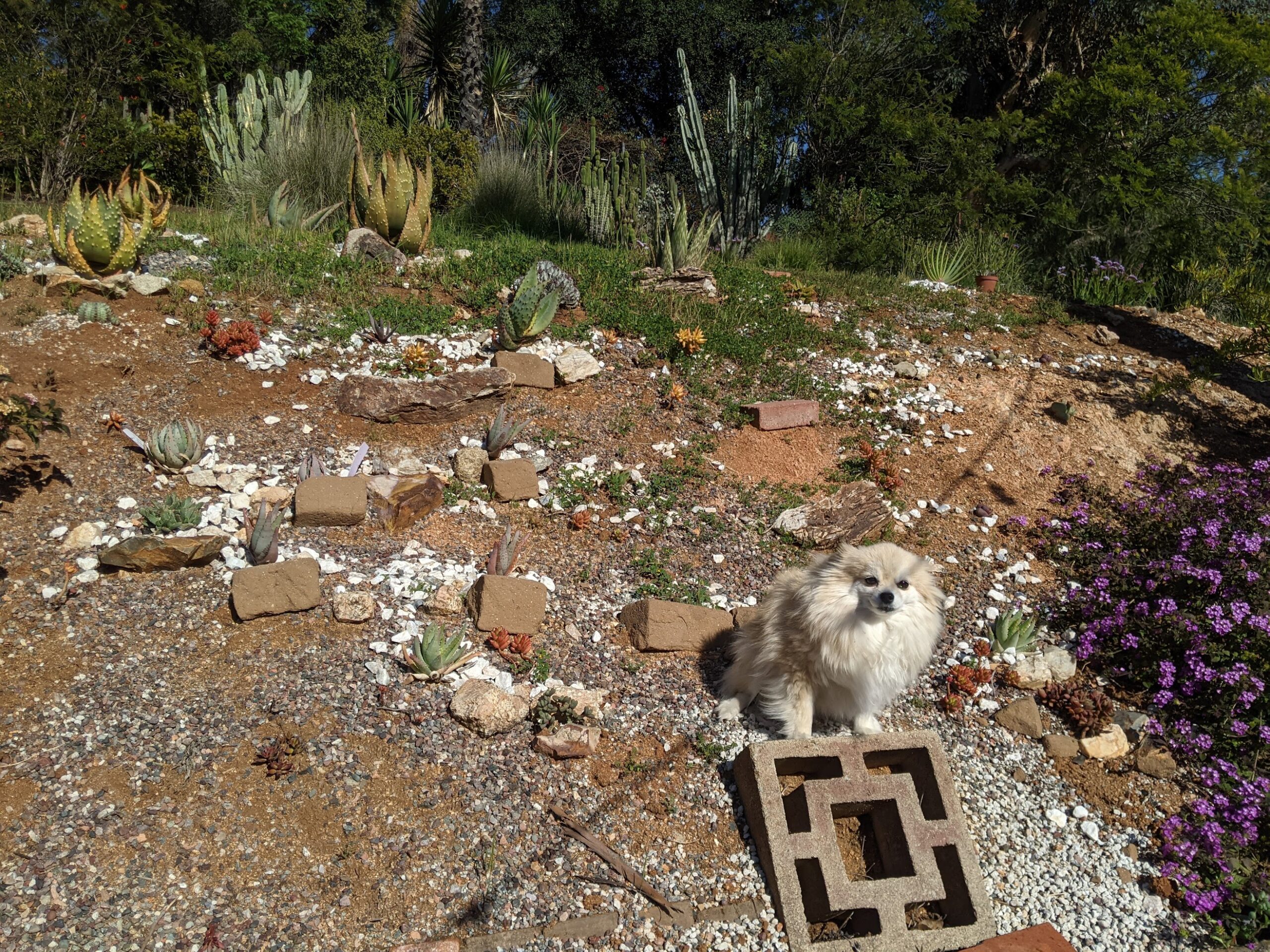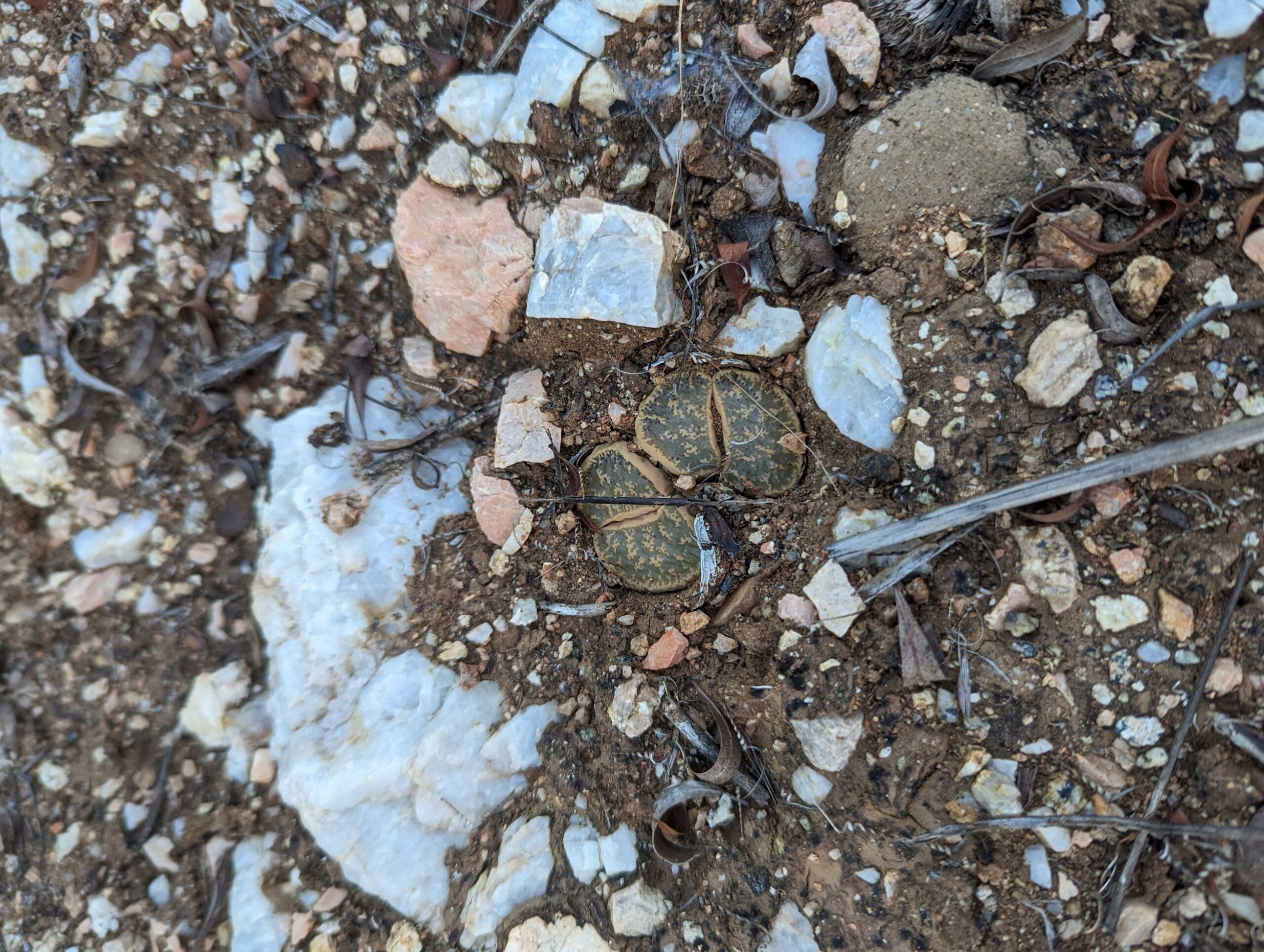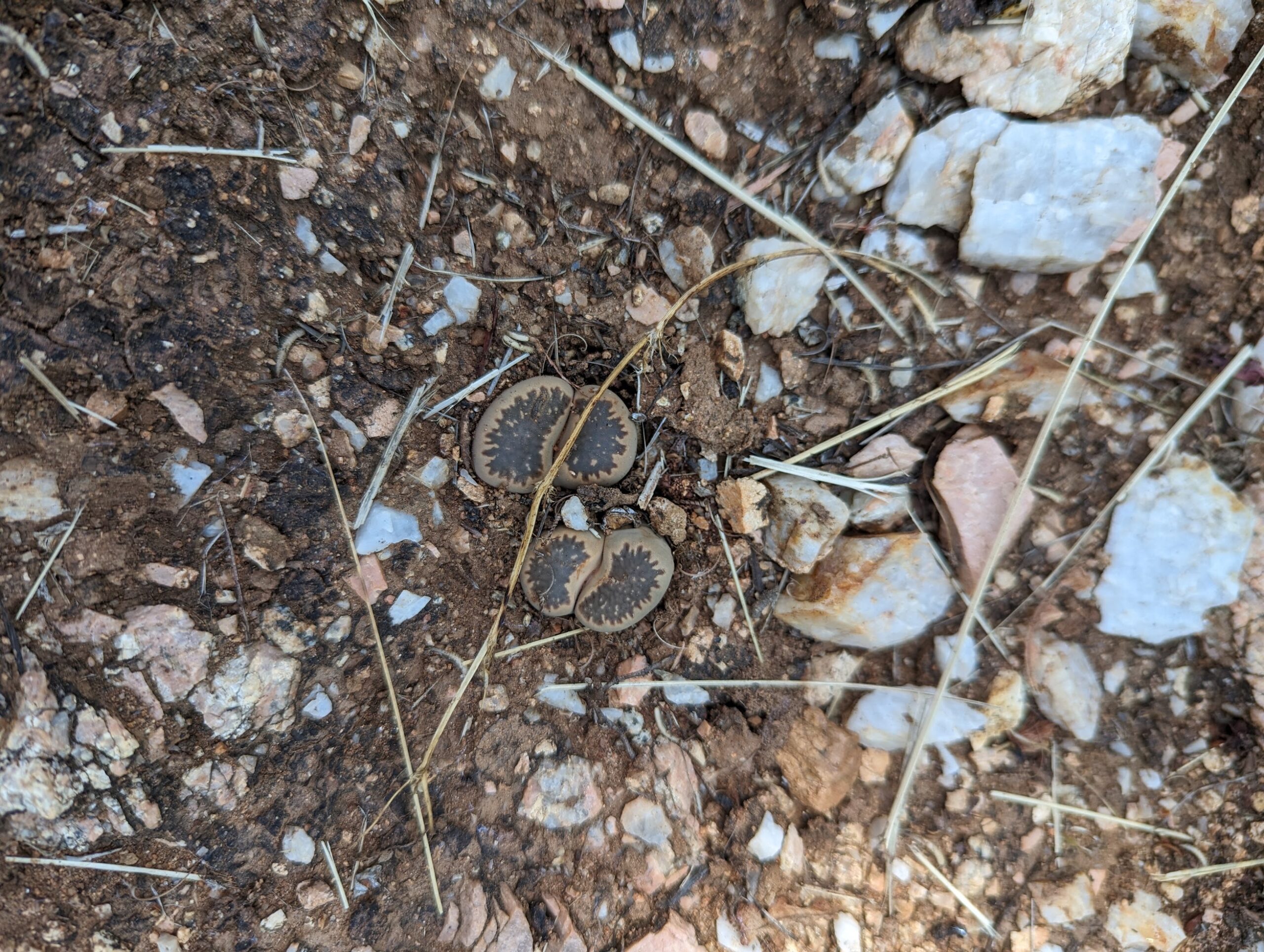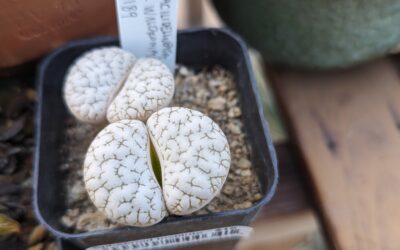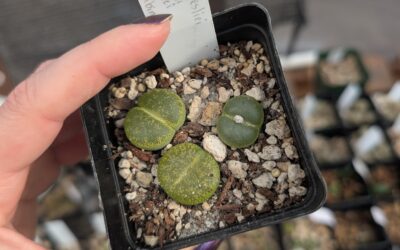One of my early pandemic projects was experimenting with ways of growing various succulents, spurred by damaged plants I couldn’t comfortably sell on Etsy. I’d plant a few specimens intentionally, with a strategy for ensuring long-term growth, but some of my plantings were just “well, let’s see what makes it.”
To my surprise and delight, my experimental Lithops slope was a huge success!
Criteria for In-Ground Lithops
Before I placed these Lithops in ground, there’s some considerations and environmental conditions to keep in mind.
The particular slope I planted these in is extremely steep; it’s almost impossible to walk up like a normal human being, you have to crawl if there’s no steps.
The slope is also extremely rocky, with large slabs of granite/quartz and very minimal organic material. The slope is east-facing, and the particular area I planted the Lithops in gets shade from a palm tree and bushes starting around 1 or 2 pm (depending on season/time of year).
My highest summer temperatures outdoors reach 110+, but only for a few days a year – rarely more than a couple days at a time. Most often, my summer high temperatures reach the 90s, with the occasional spike into the 100s for a week at a time. Nighttime summer lows are in the mid 50s at the absolute lowest, more often in the 60s (the worst weeks have nights that don’t go below 75).
In winter, the highs are typically in the 60s, with occasional weeks drifting to the 70s. Nights get chilly, down to the 30s and 40s, and we get the majority of our moisture in late winter and early spring. Occasionally, we get hail, but that’s a once every-few-years sort of event with pea-sized hail. Morning frost does occur, but it’s mild and dissipates within an hour or so of sunrise.
So, your TL;DR:
– Zone 9b
– On a steep slope (excellent drainage)
– Rocky, highly inorganic soil
You can probably mimic some of these conditions if you’re also in a warmer and southern area of the US, but those who aren’t in this funky microclimate may find this a bit baffling.
The right hand side of this photo (just above the purple blooming bush) is where all my Lithops were planted.
Kitty the Pomeranian as an involuntary prop to display size/scale.
In much of this slope, I planted aloes – particularly South African species that thrive in high temperatures, stress, and lots of drainage.
There’s a marlothii in the middle, several aculeata, and about a year after this photo was taken, I added spectabilis to the hill.
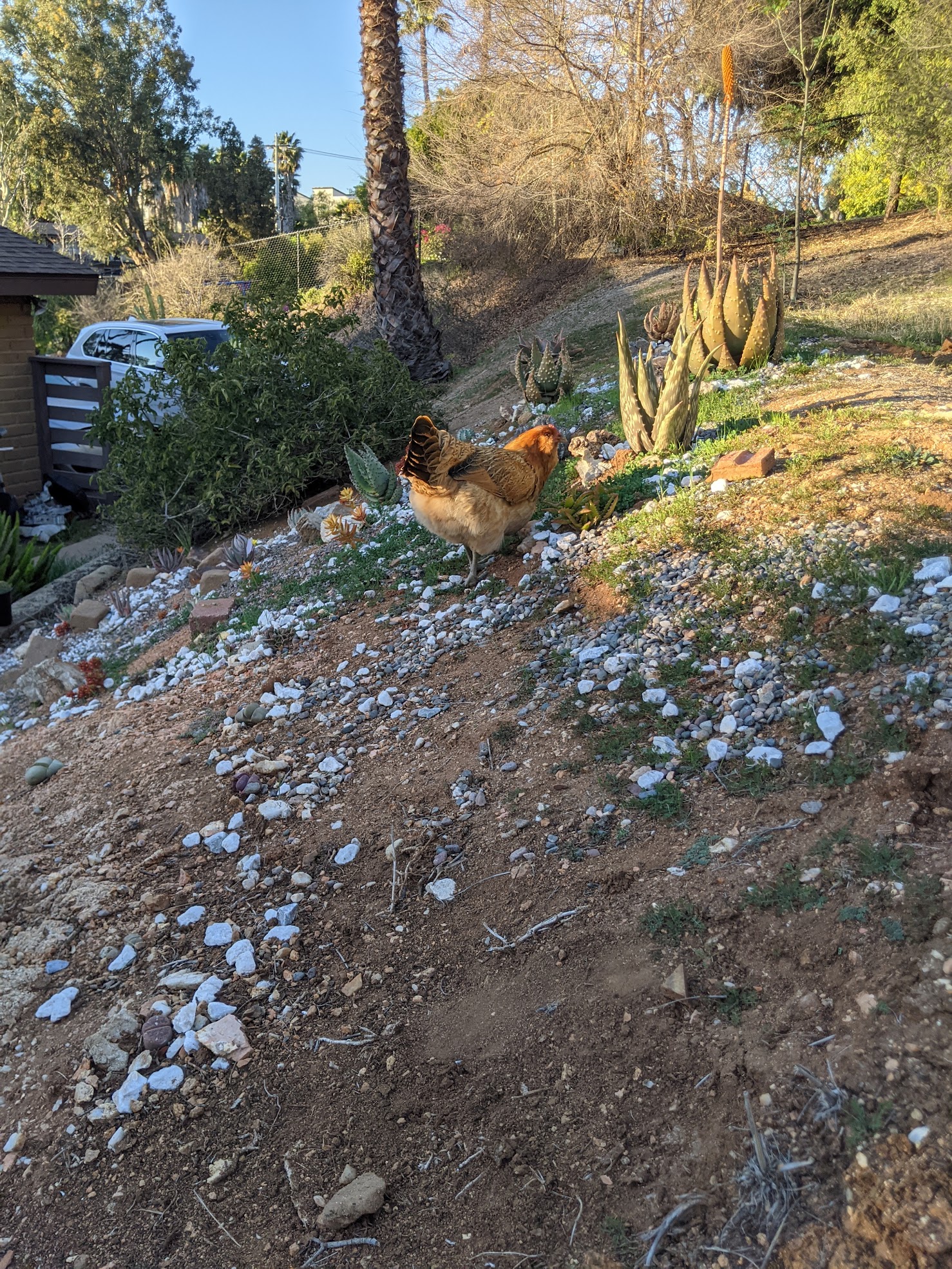
One of the biggest predators and risks for my early lithops plantings: our chickens
Species Planted
I absolutely did not plant any named or clearly defined species into my experiment hill. These were entirely lithops from a local wholesaler with no specific species or Cole numbers, and all variously disfigured from mice, snails, or sunburn.
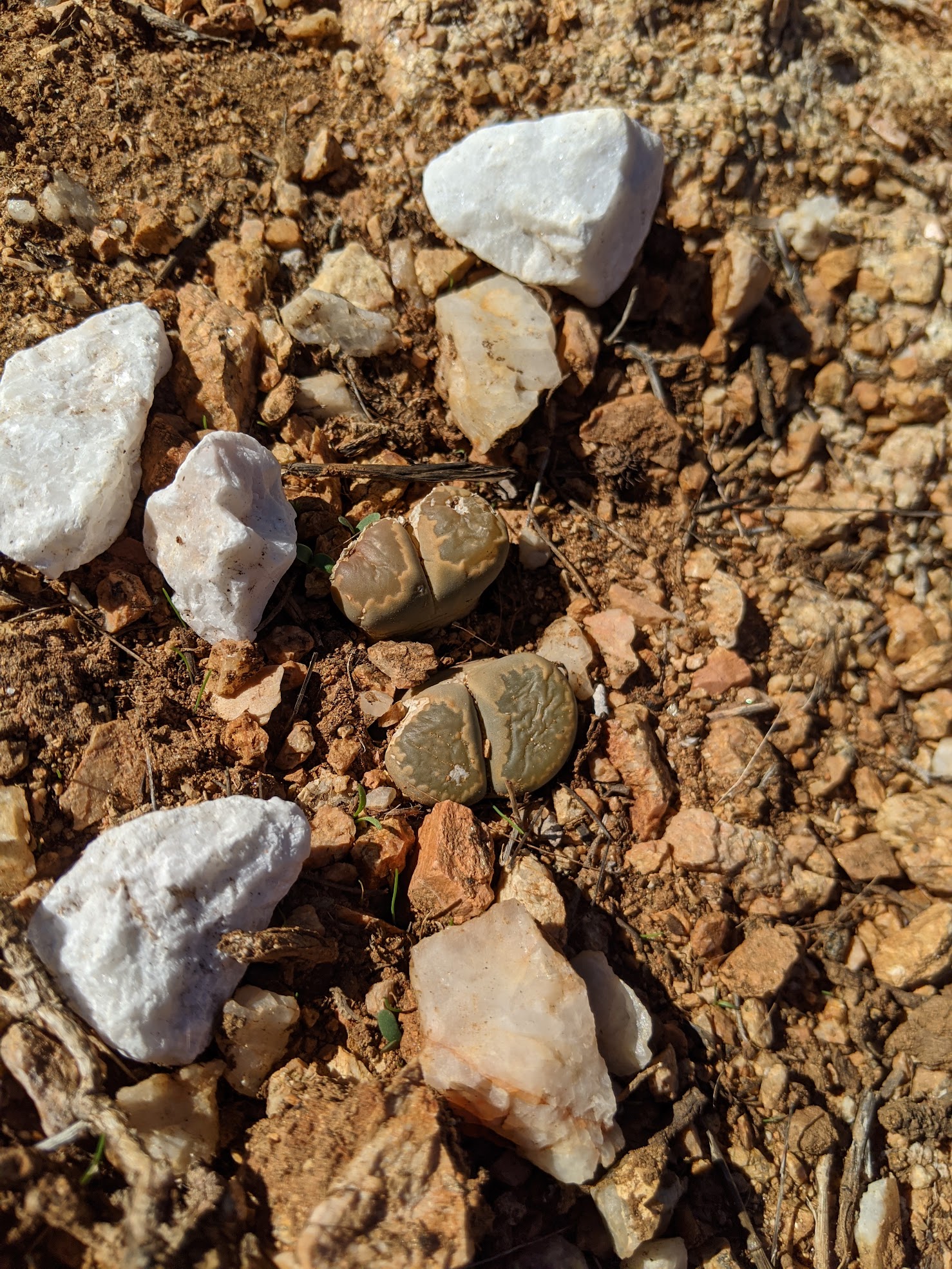
An example of the Lithops I planted; this is from fall of 2020. You can see physical damage and shriveling.
I’ll show a few photos of this particular Lithops over the next few years first, as this one slowly began to clump over time. To plant them, I used a small trowel to pulverize the stones and create a crevice for the Lithops to get planted into. I also placed marble chunks (from Home Depot) and chunks of quartz from the digging around the plants to help myself spot them later on.
This didn’t last, but it was a nice effort.
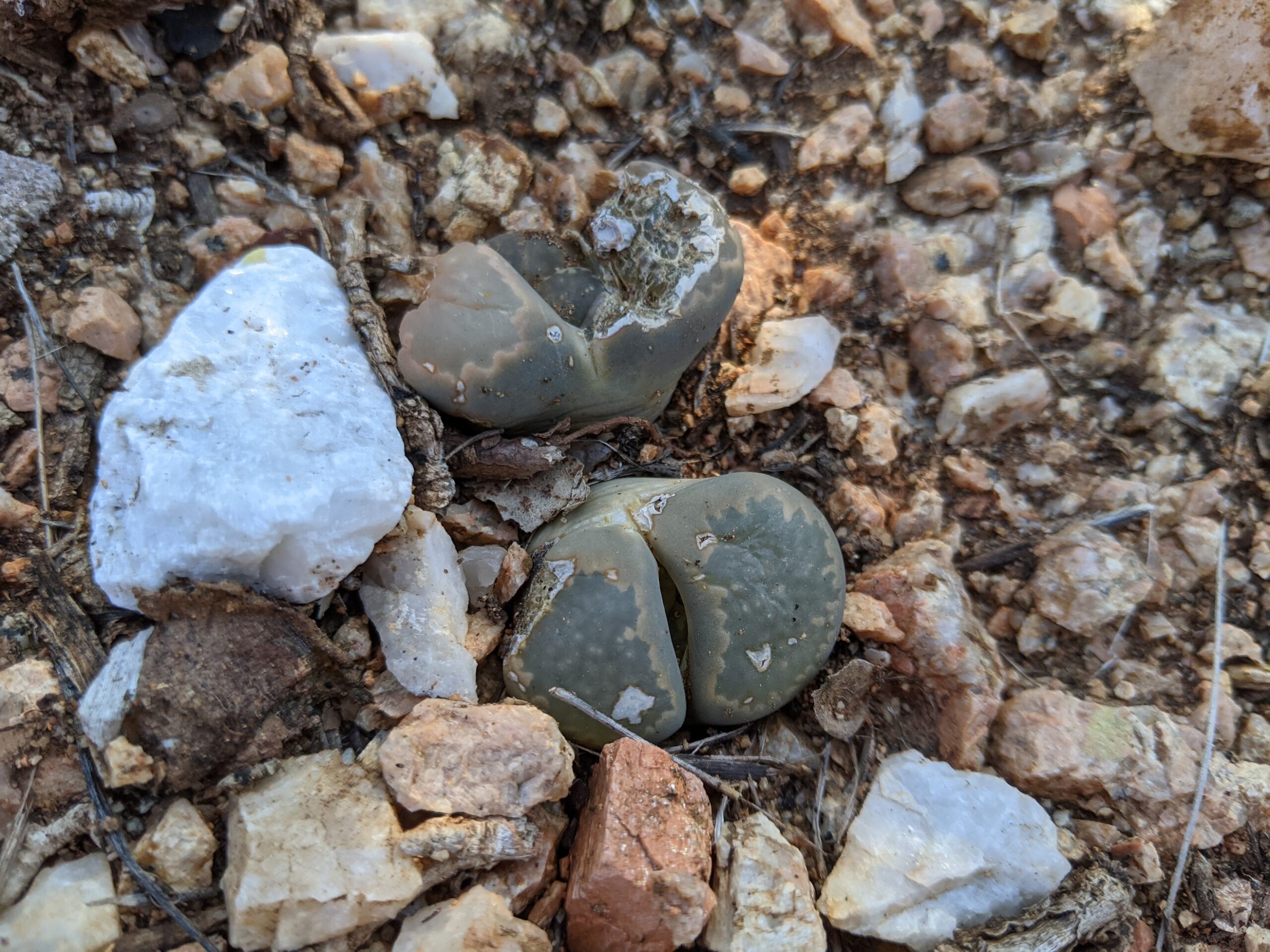
In February of 2021 – you can see new damage from something trying to eat these guys, but they’re champs and ignored it.
It’s worth noting that this is the phase in growth for potted Lithops that they should not be watered, and should be allowed to absorb the energy from the older leaves.
I’m not sure what species or hybrid this particular plant is, but it divided into multiple heads more rapidly than the others.
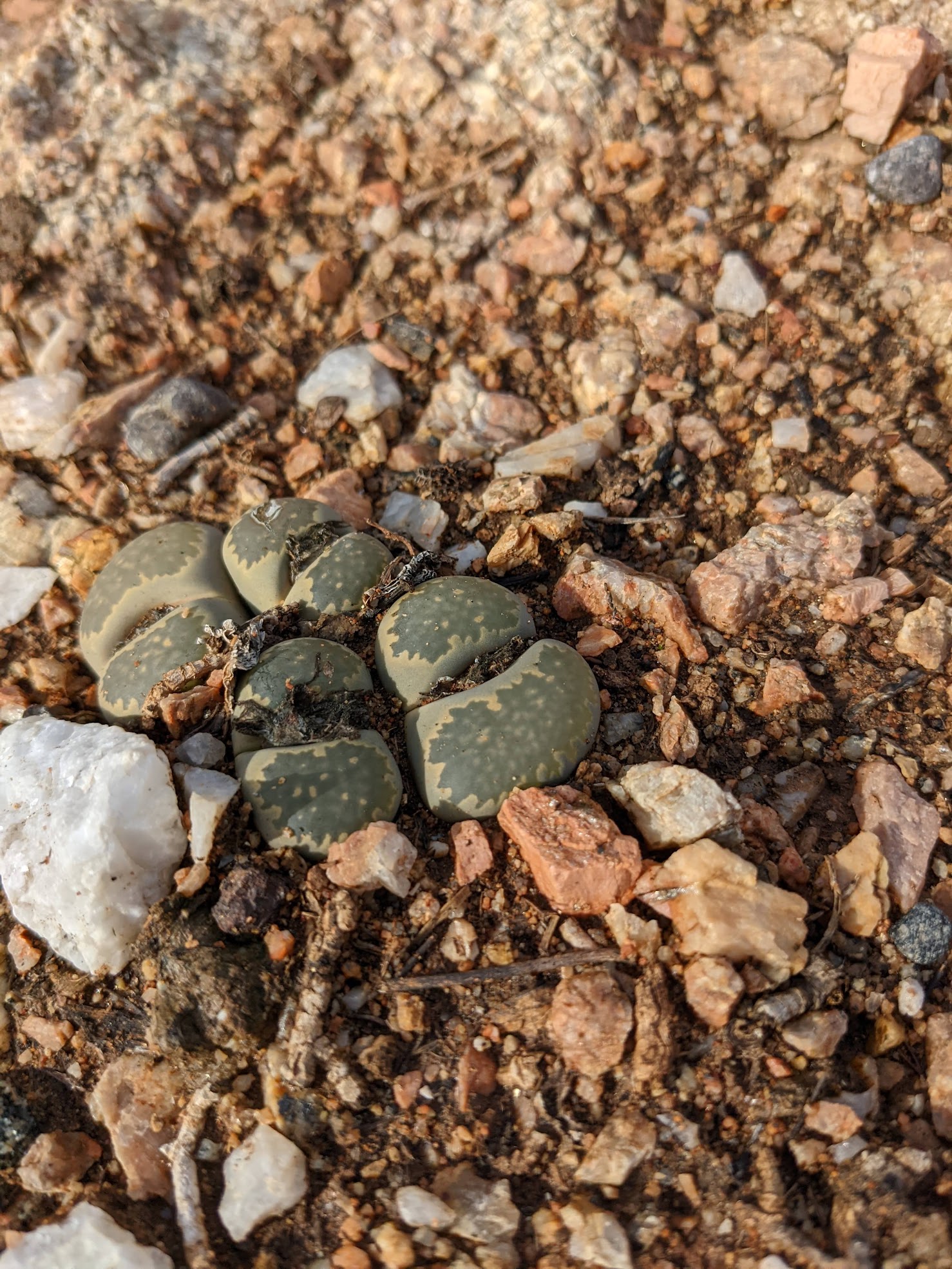
Same clump, December 2021. As you can see, the two heads divided into four!
The lithops stayed this way for a few years.
You can see some spent blooms, the beginning of seedpots, and the color and windows that the species is known for. For these lithops in ground, December became the time for them to grow and build up resources before they began to divide later in winter.
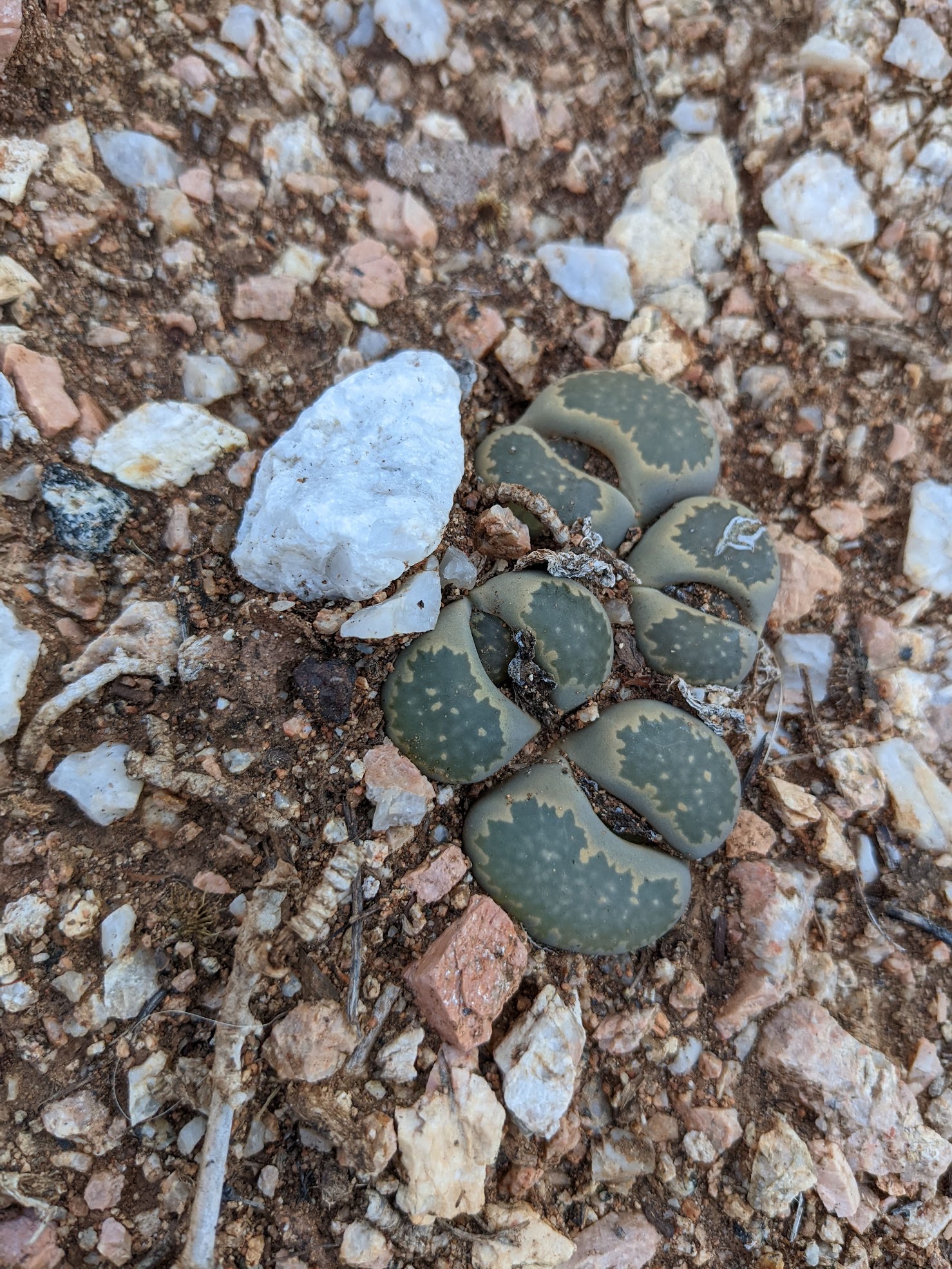
Same clump, February 2022.
You can see the new leaves peeking out from the old leaves! Again, in pots, you shouldn’t be watering these at this time. But…being in the ground, these lithops are being watered when the weather gods decide. In our region, most of the rain seems to come from mid to late January and intermittently until May, less commonly, until June.
In recent years (2022, 2023, 2024), we’ve recieved most of our rain in March and April.
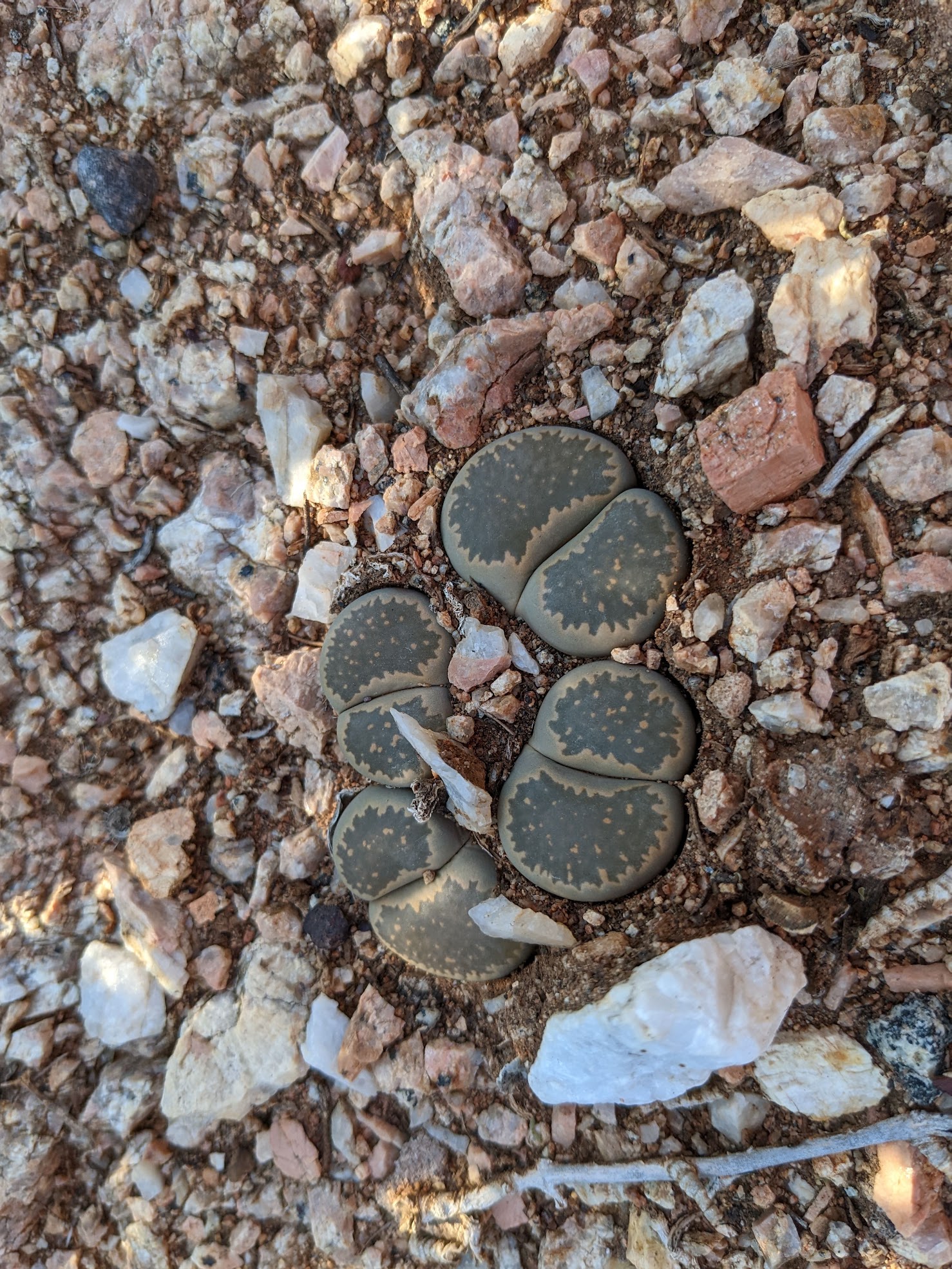
No new heads grew in 2022. Above, the Lithops are nice and plump after being watered a couple days earlier in September of 2022.
You can just barely see the leaves beginning to split, indicating the start of the Lithops producing flowers. In fall, with the shorter days and cooler nights, they wake up and seem to gather some energy before producing flowers. All the Lithops on this hill tend to start blooming around October or November, so this was still early in the season.
I do water these plants all through summer, rarely more often than once a week.
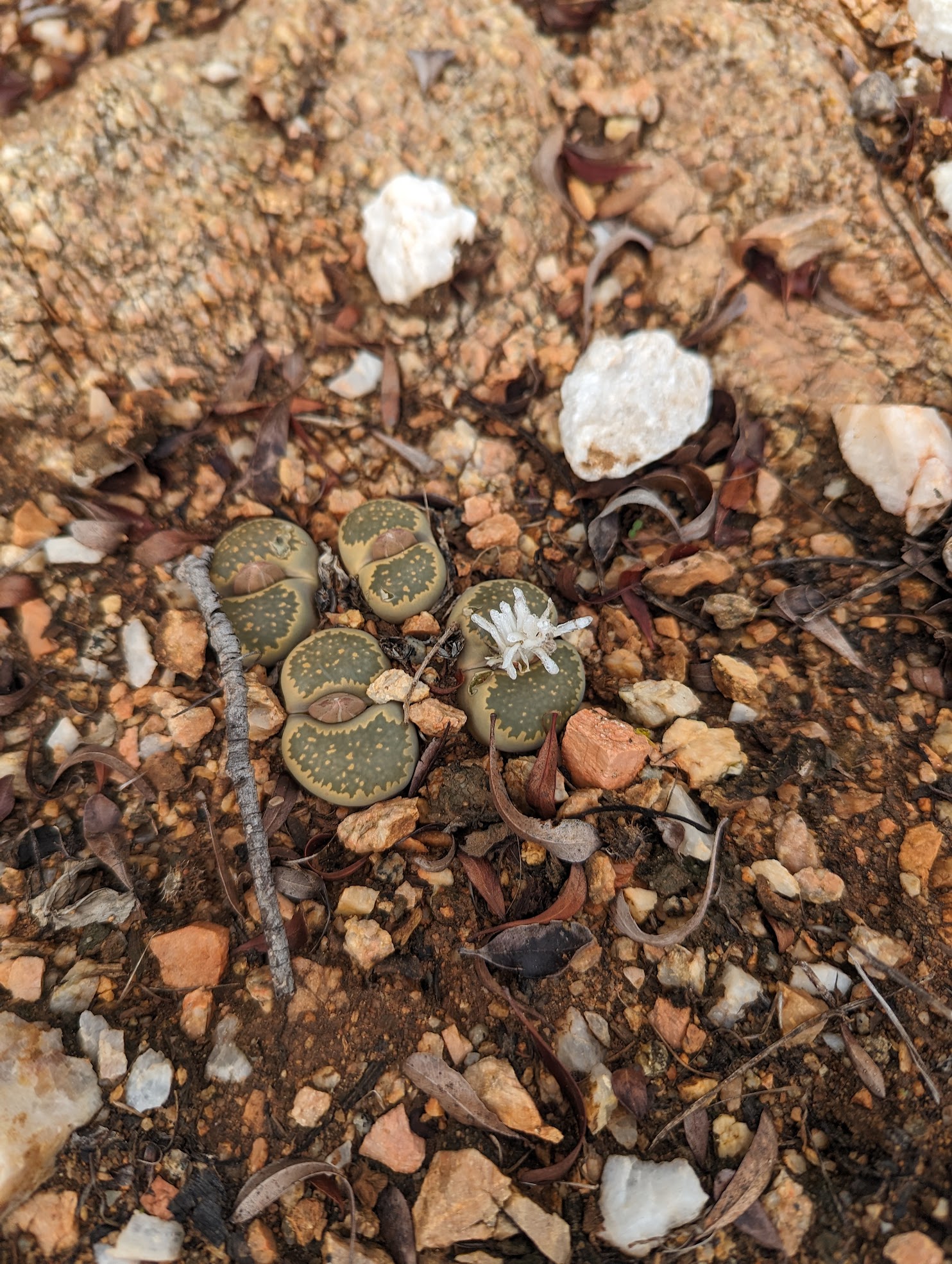
And here they are, a year later! This is in November of 2023, showing the typical seasonal blooms I’ve come to expect.
This particular hybrid will produce white flowers, and regularly makes seed pods. I’ve never seen any baby lithops pop up, but maybe with a wet enough winter, we’ll get some volunteers.
If you look closely, you might notice there’s some physical damage to the heads; animals do regularly try sampling these survivors, but they never really eat the entire thing. I’m not sure why, but I’m glad the tend to leave them alone!
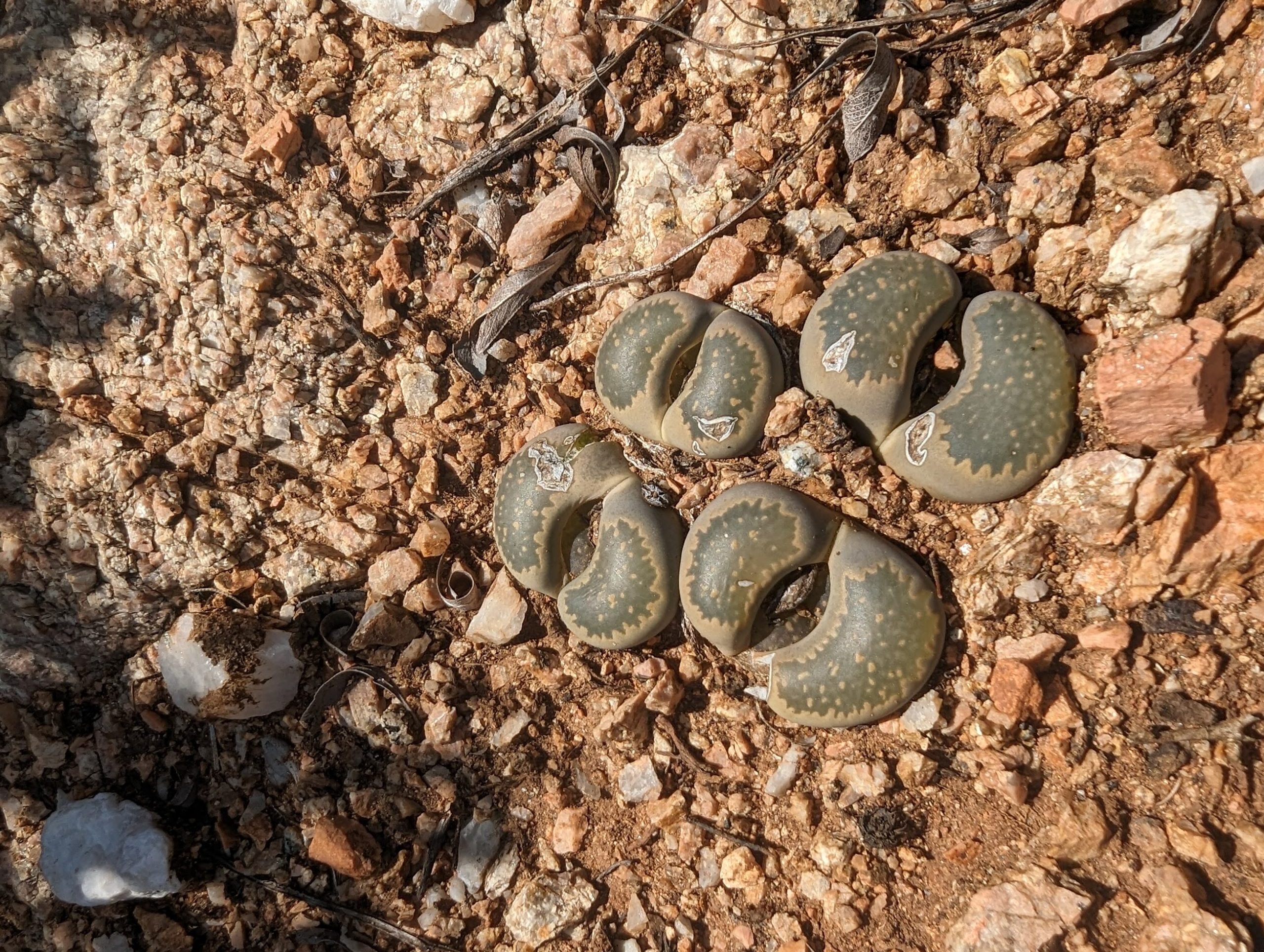
And here’s the same clump, March 2024 – this year! The clump produced new heads this year, from 4 to 7 total leaf pairs.
This year, I waited longer than usual to start watering the slope these are on, and they started to really get brown compared to previous years. When reviewing images for this blog post, I almost thought I had my plants mixed up – but no, these really bronzed up with some water stress.
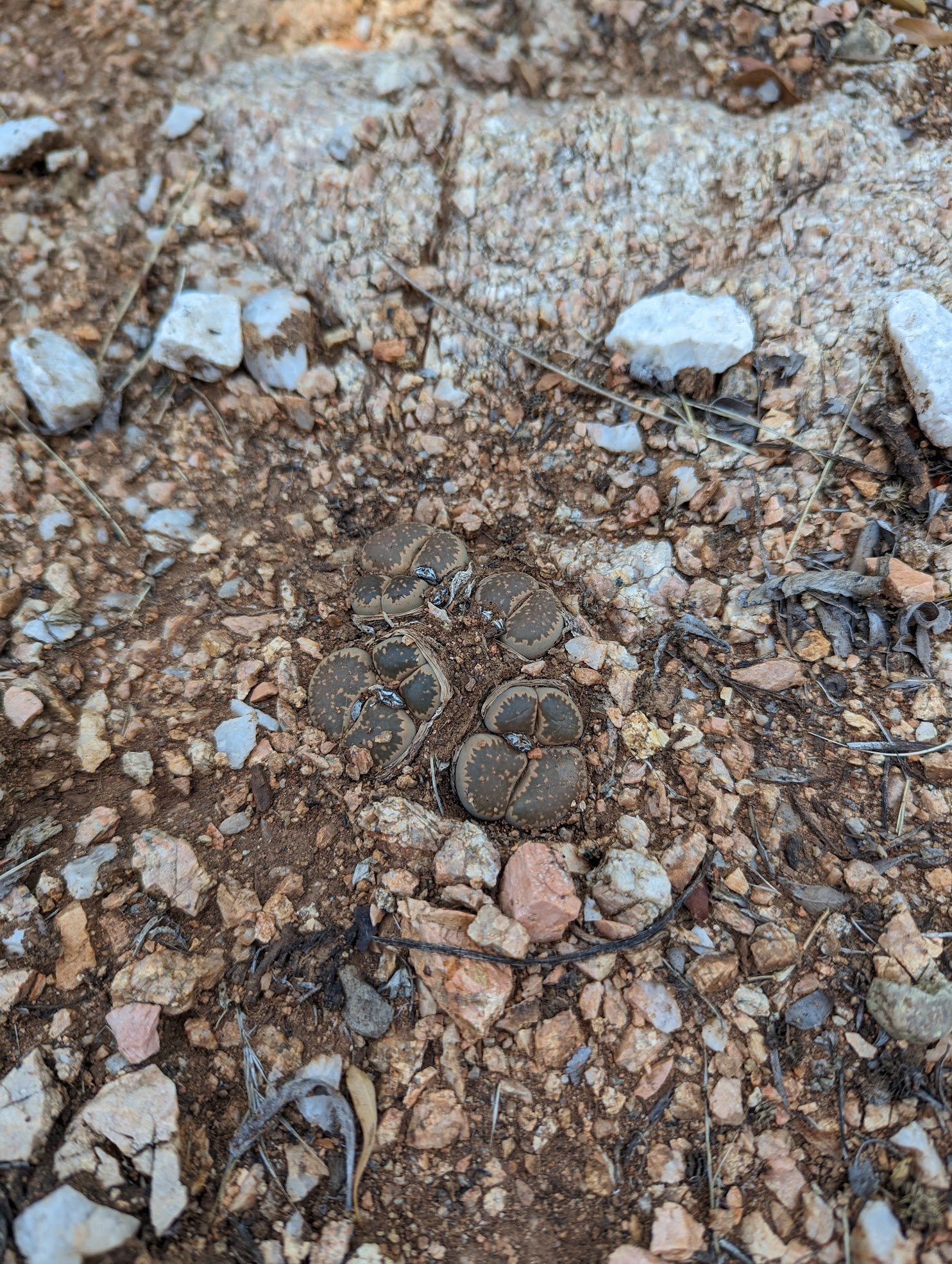
Same cluster in June 2024, showing seed pods and the multiple heads. You can see the dried skin on the outside of several head clusters, and some soil has washed down onto the clump from the sprinkler running the night before.
And so this clump heads into the fourth summer since being planted, and I’m pretty optimistic about it surviving!
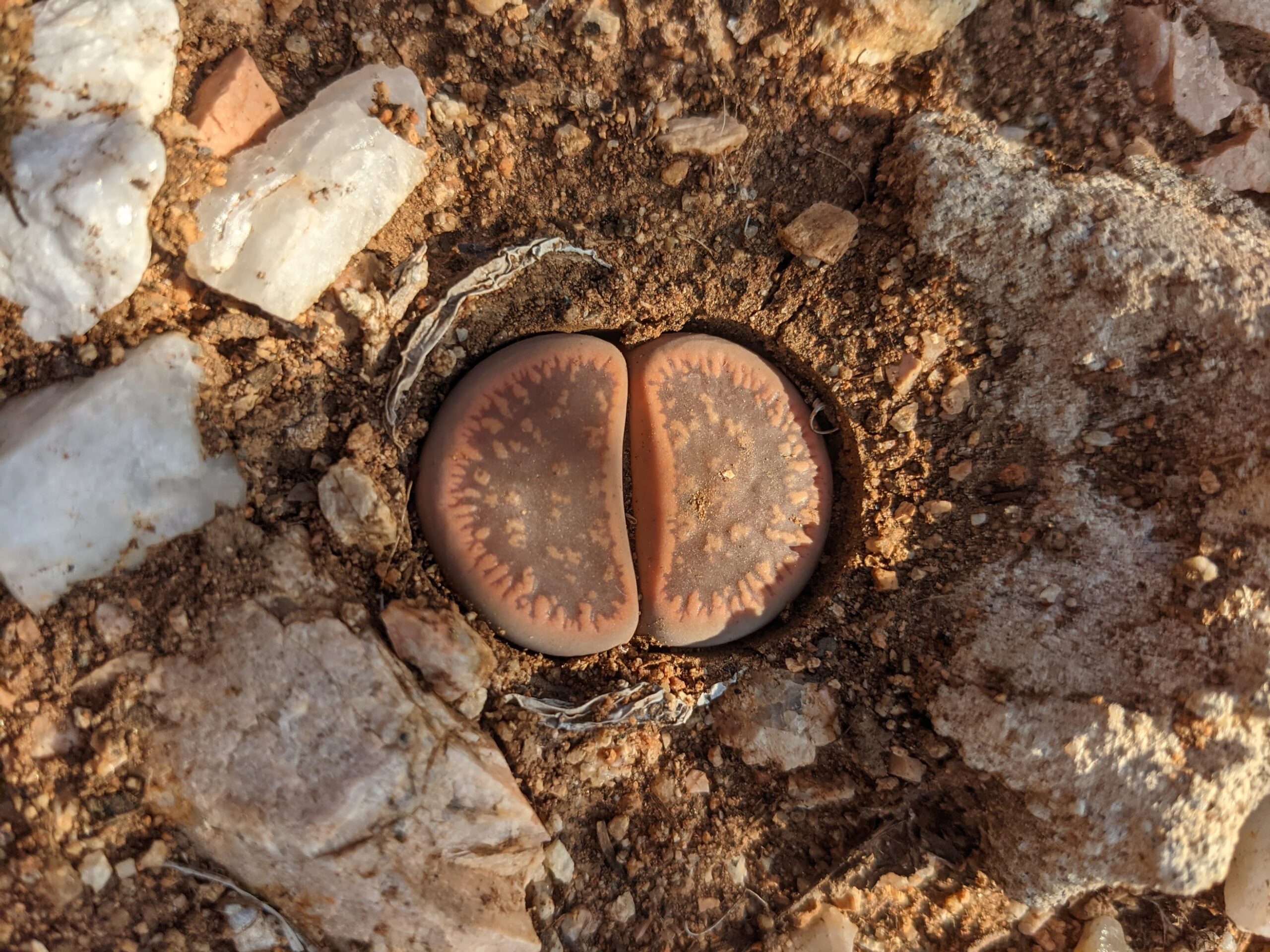
I’ll show the growth of several of the others – this one is a reddish hybrid that is very pretty.
At left, it’s showing the way they withdraw into the soil around them when they’re thirsty. This photo is from September 2021, and I likely hadn’t watered in several weeks that year. I also appreciate that you can see the old leaves as crispy debris at the edge of the plant, which is what your own plants should look like.
Unlike my big clump, this one has been slow to produce new heads.
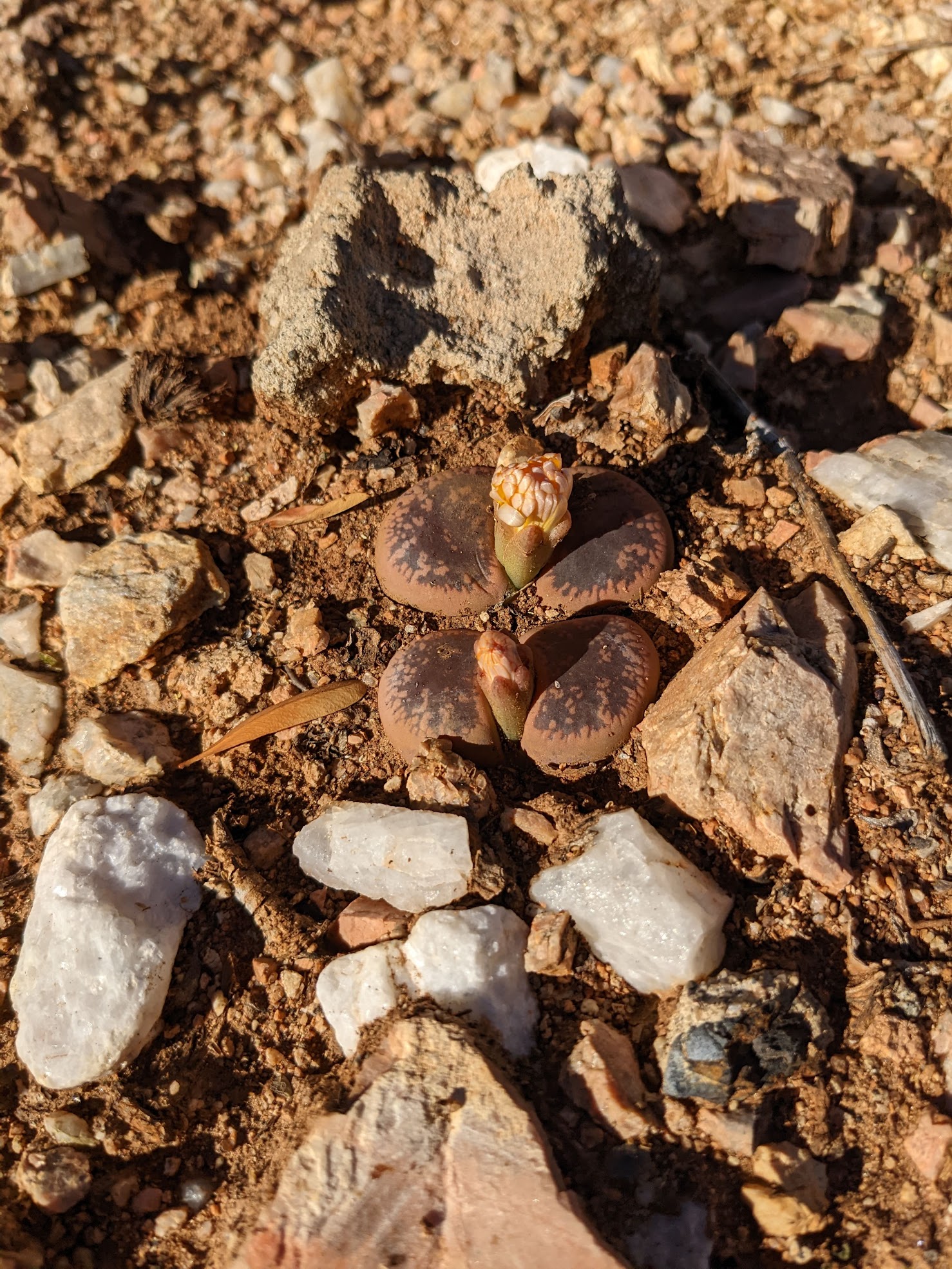
After an initial split when being planted in the ground, producing the two heads above, this one hasn’t produced any more since 2022. The photo above is showing some blooms getting ready to open in the morning, November 2022.
This one produces more yellowish flowers, which is fairly typical for lithops.
You can also see a little gap and sharp outline of the very rocky soil around the top leaf pair, indicating that the plant is starting to get a little thirsty. Totally fine! I try to wait until the blooming is done to water them again, but even the potted Lithops will happily take some water while they’re blooming.
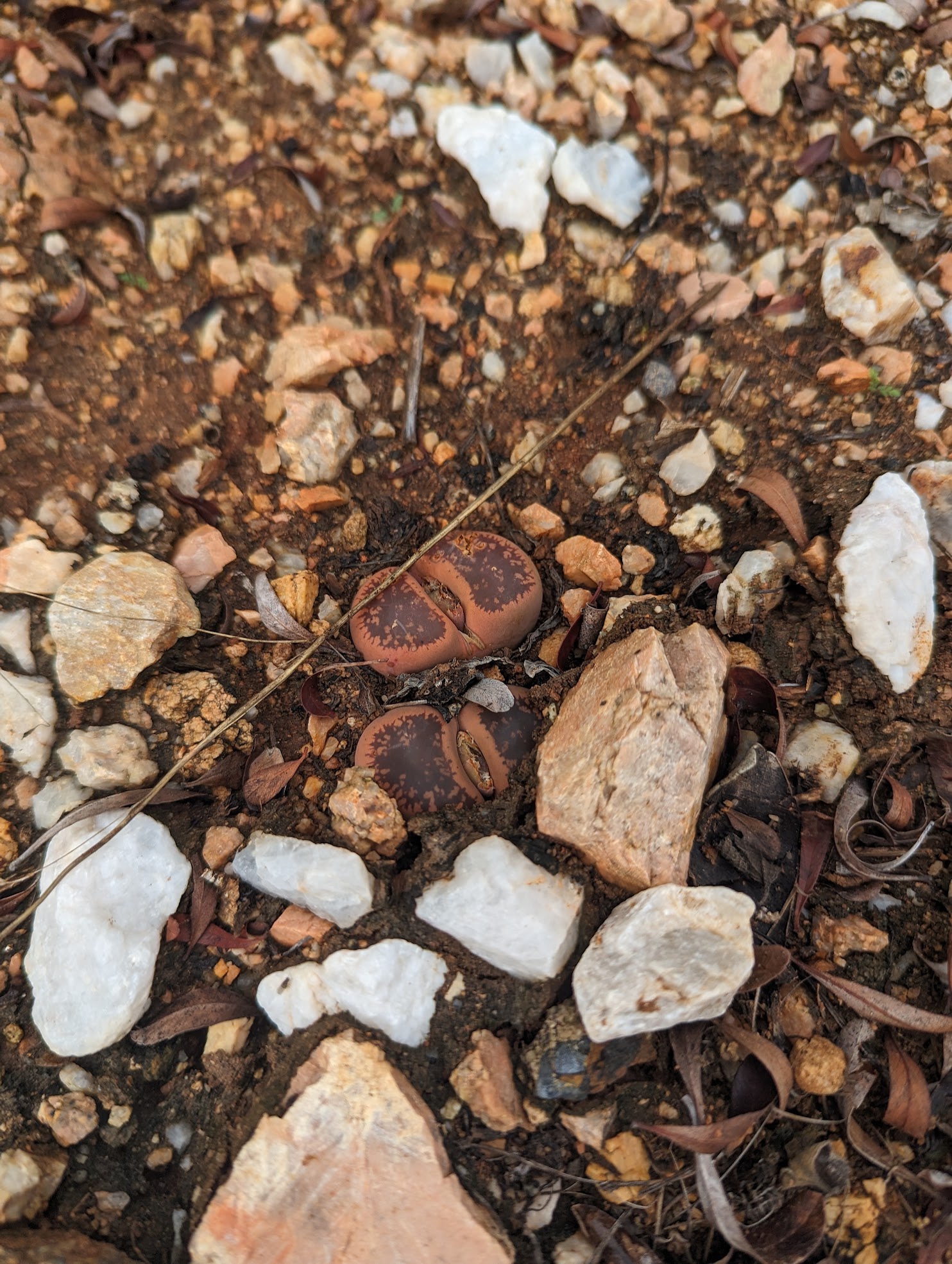
And a year later, November of 2023.
I love the reddish hue of this hybrid! It also pretty routinely gets covered by dirt and rocks, and I’ve had to go hunt for it and uncover the heads to keep it growing.
You can see that this photo is later in the cycle than the one from the previous year, as there’s no flowers, just the spent bloom stems preparing to turn into seed pods.
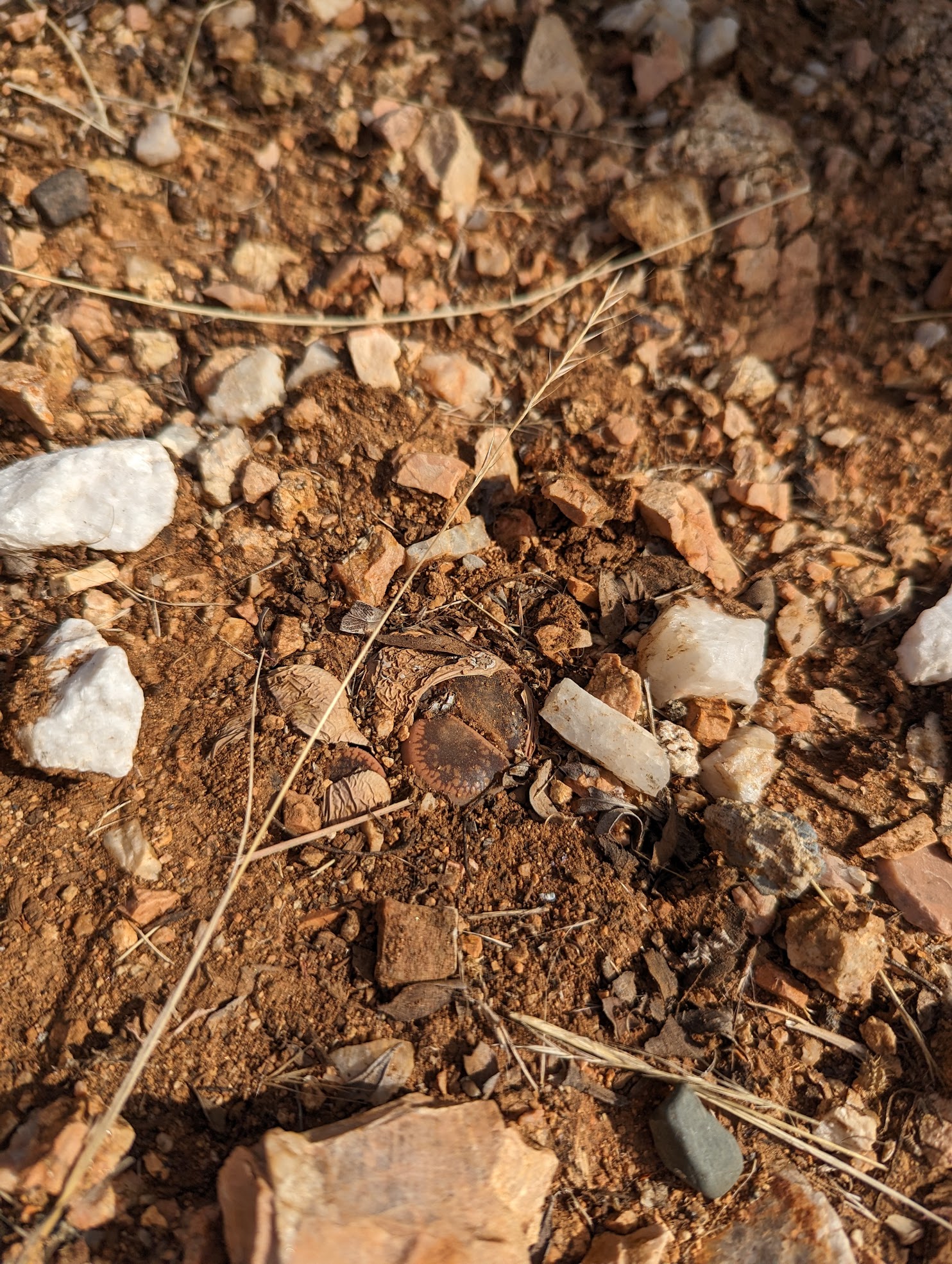
Same pair, showing what happens if I just leave them. This photo is from May 2024 – I hadn’t watered the slope at all for the year yet.
With the dirt and debris cover the leaf pairs, as well as old leaf sheaths covering them somewhat, this Lithops fared pretty well. The month of May was also pretty mild, with lots of cloud cover and misting rain.
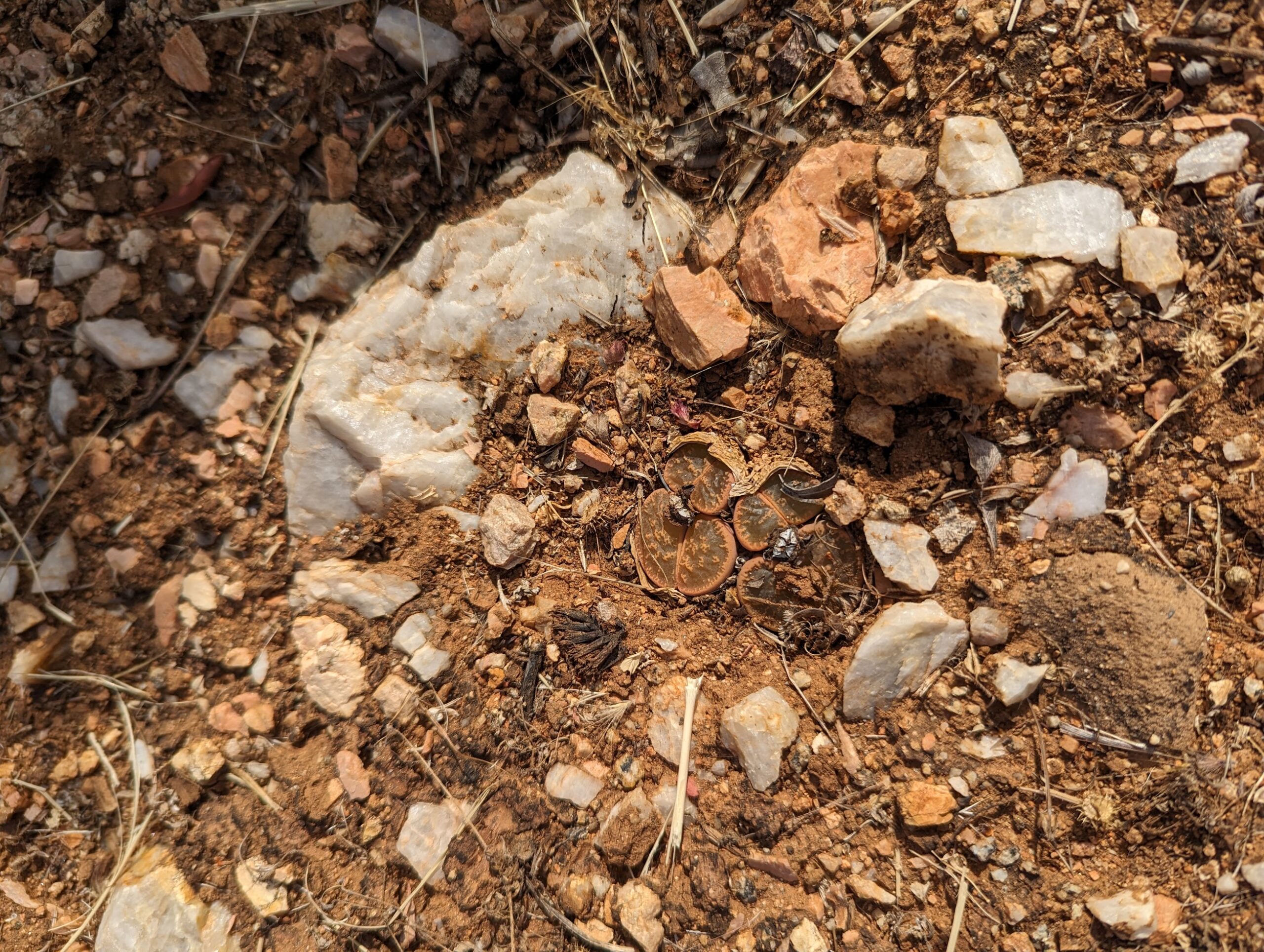
Not far away, this clump of lithops was big-time on the struggle bus in the same month (May 2024). There’s four leaf pairs here, and they are very wrinkly. The clear parts of the leaf bodies have sunk in somewhat, with the opaque portions standing out in relief against the transparent portions.
There’s also some dried, old seed pods visible between the leaf pairs.
When I looked closer, similar to my red-headed specimen, this one also had a plumper head where it was partially covered by dried weeds and soil. If you see your own potted lithops looking like this, it’s time to give them a nice drink.
And I just want to reiterate…the only water these received up to this point was rainfall. In 2024, we received a TON of rain in February and March (our area received over 3″ in a single week from one storm, and we had several in a row!), with some morning mist in April. By the time I took this photo, they hadn’t had any rain or appreciable water at all in over 2 months.
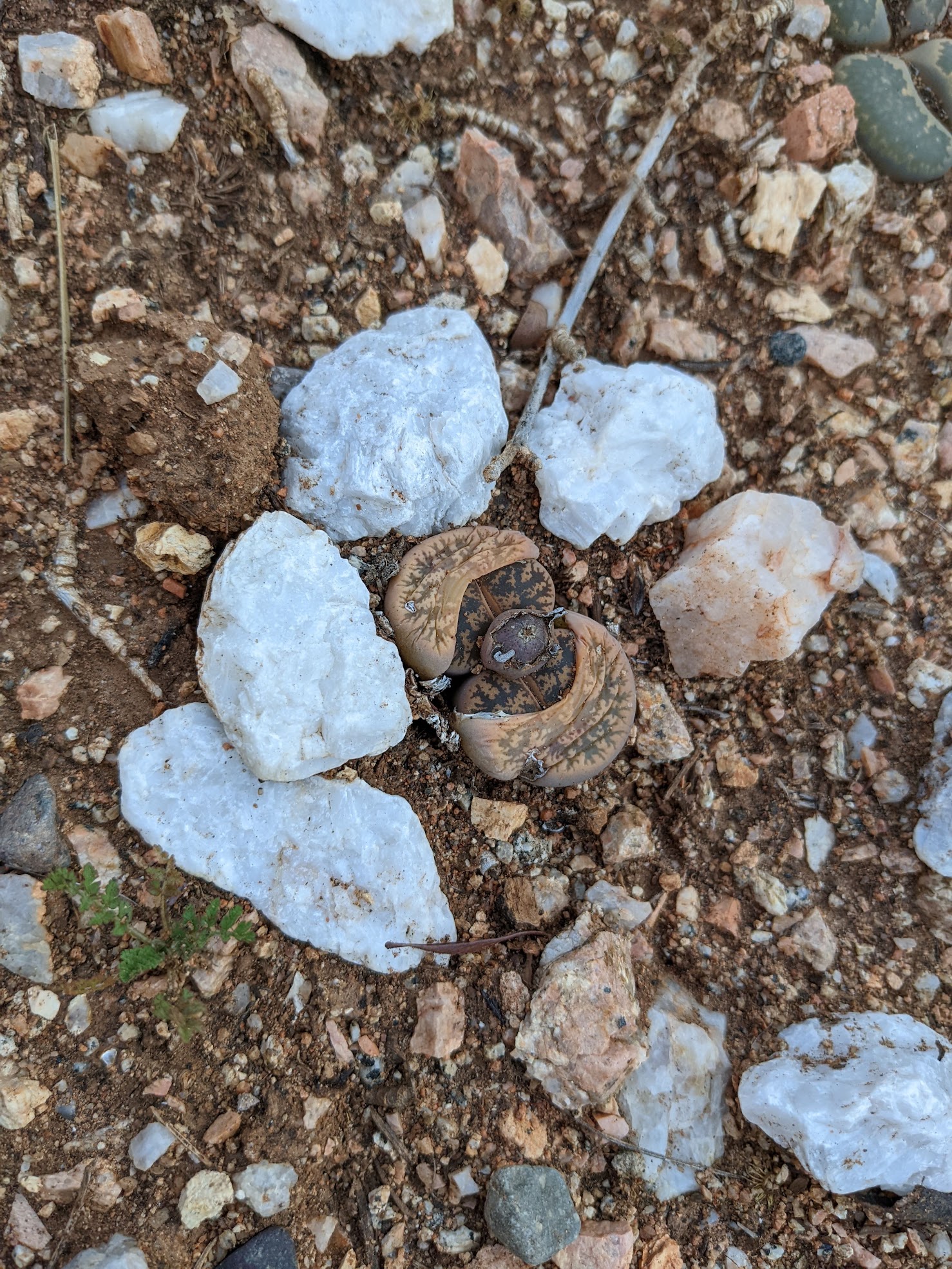
A different clump showing the absorption of old leaves and producing new leaf pairs – this is from February 2022. You can also see a ripening seed pod in the center.
This brown hybrid tends to do the best of all the specimens in the ground, likely because the color helps it blend in so well among the dirt and rocks.
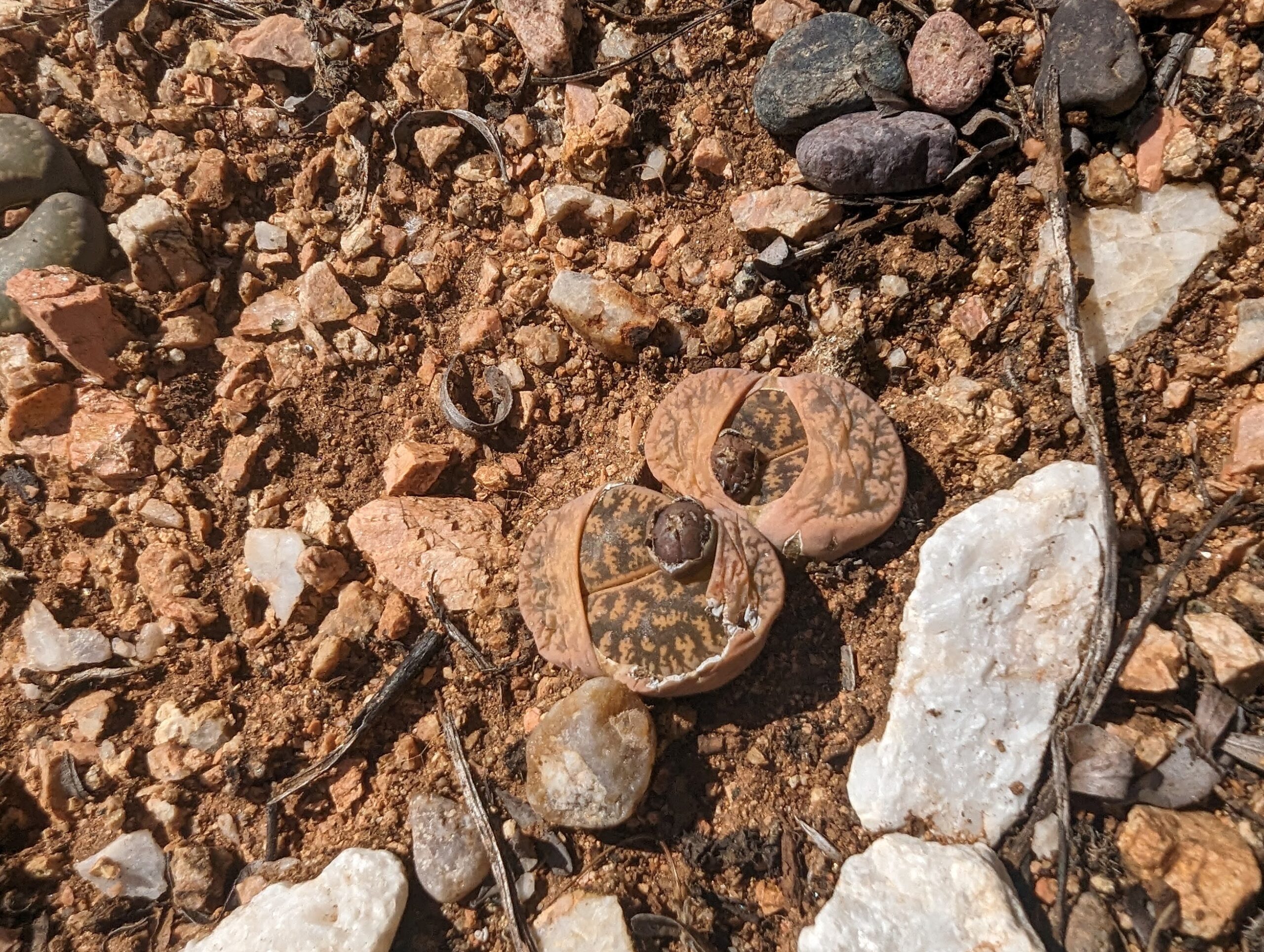
Same plant, March of 2024 – looks like this year, it’s producing a third leaf pair!
Since February and March were such wet months for us, you’d expect issues to arise from the Lithops dividing and absorbing old leaves while also getting tons of moisture. From what I’ve observed with mine, being in the ground makes them far more opportunistic and accepting of moisture outside of what much cultivation wisdom would tell you.
Typically, in a pot, when you see your Lithops dividing like this, you should withold all water. You’ll want to see the old leaves fully be absorbed and pull back, giving their energy to the new leaf pairs.
With my in-ground plants, they proceeded like nothing was amiss even with frequent rain as they divided. The only issue I could see was that with the rain, the old leaves weren’t absorbed very quickly, which did lead to the old leaves covering the new ones as they entered summer dormancy. But…that’s not always a bad thing, not with our high temperatures and intense sunlight.
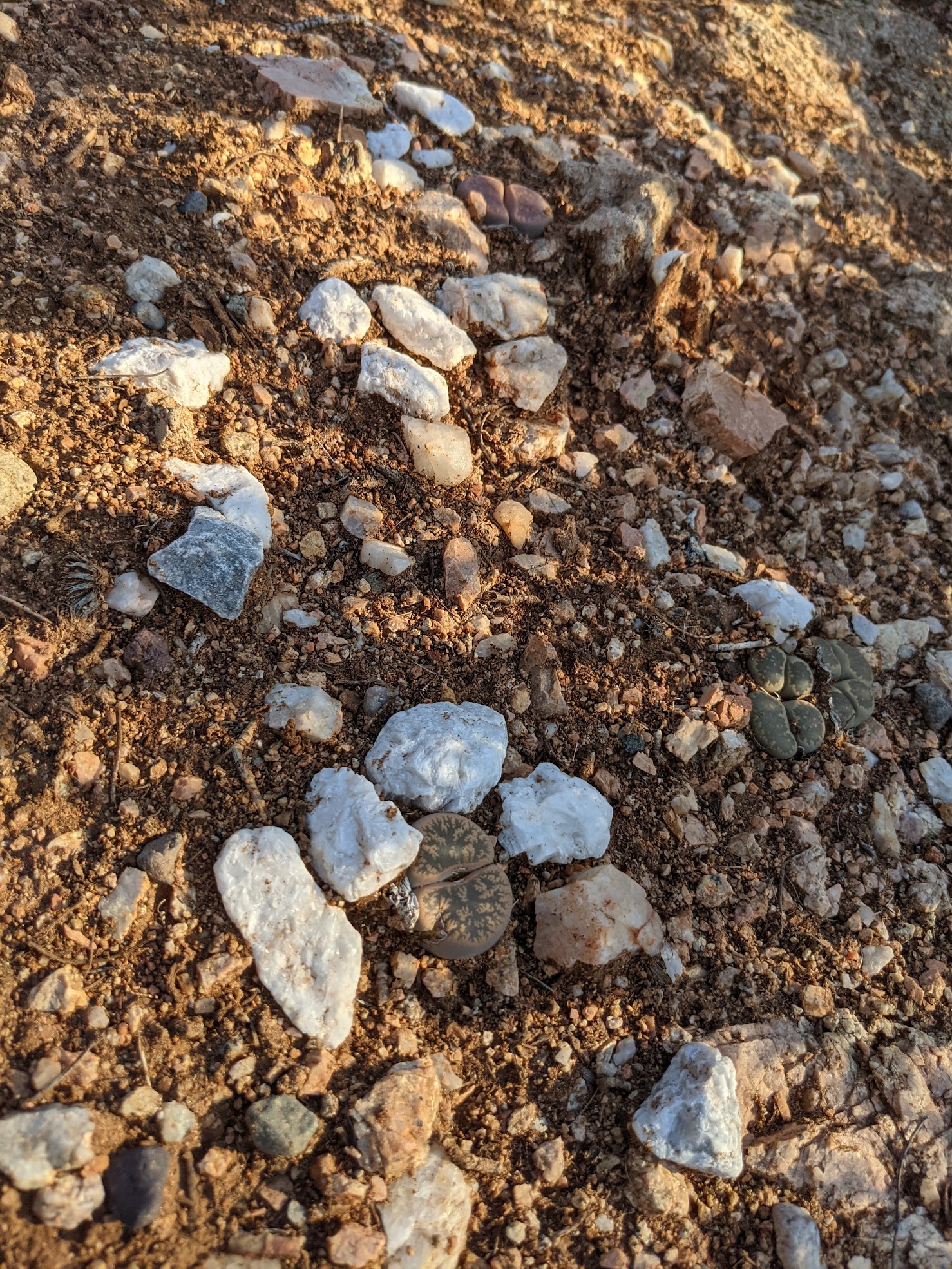
Three of my original planted Lithops, September of 2021.
You should be able to see my lovely red-hued hybrid at the top center, the fast-clustering group at the right middle, and then the brown-hued Lithops in the forefront.
Nice, plump, and just starting to separate to make their flower buds.
If you look at all three, you can see just a bit of a separation beginning. The center seam between the leaf bodies isn’t tightly wedged. The ever so minor split is most easily seen in the red-hued plant at the top; the shadows show that the leaf pair are just starting to separate ever so slightly.
It takes these little plants a long time to do anything, and 2 months spent waking up and making their little flowers is entirely in character. With your own Lithops, look for their subtle cues that they’re waking up and starting to grow again. That means it’s time to water your potted plants!
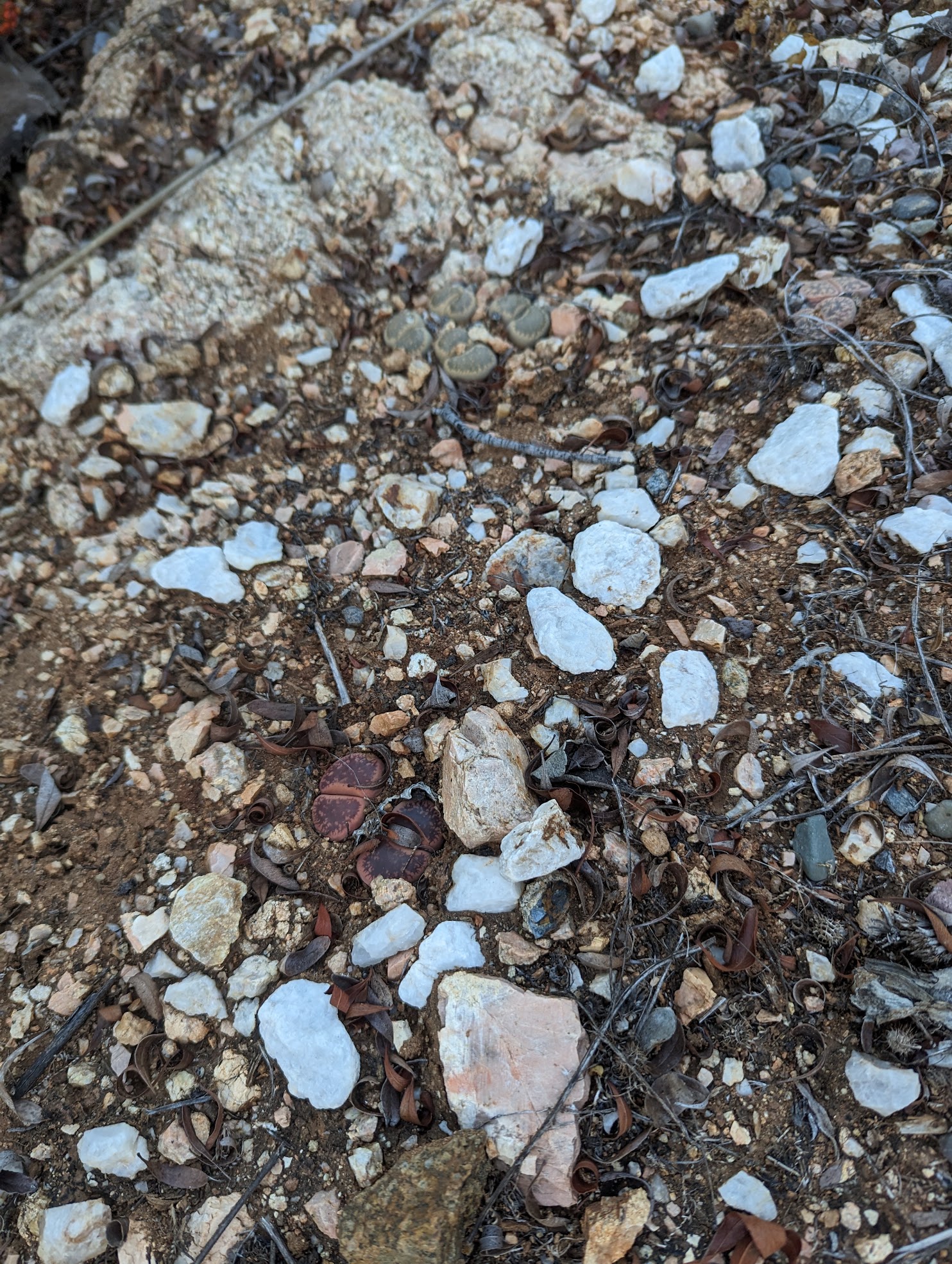
Same three from a different angle, in the morning mid-October of 2023.
I’m genuinely enamored with these little plants, and while I worry every year about keeping them in the ground and whether they’ll survive another year…they’re genuinely thriving.
Usually, October is a month where I’ll water the slope only once or twice, depending on how hot it is. Recent years have seen Octobers with daytime highs still reaching 90F! When I’ve lost some of my other Lithops planted in this hill and it wasn’t to something eating them, the two that shriveled away did so by the end of summer.
For how I have these planted, the regular summer water isn’t just something they tolerate – they seem to really need it!
2024 Watering Season
A before and after – can you spot all 6 of the lithops surviving and thriving on this slope?
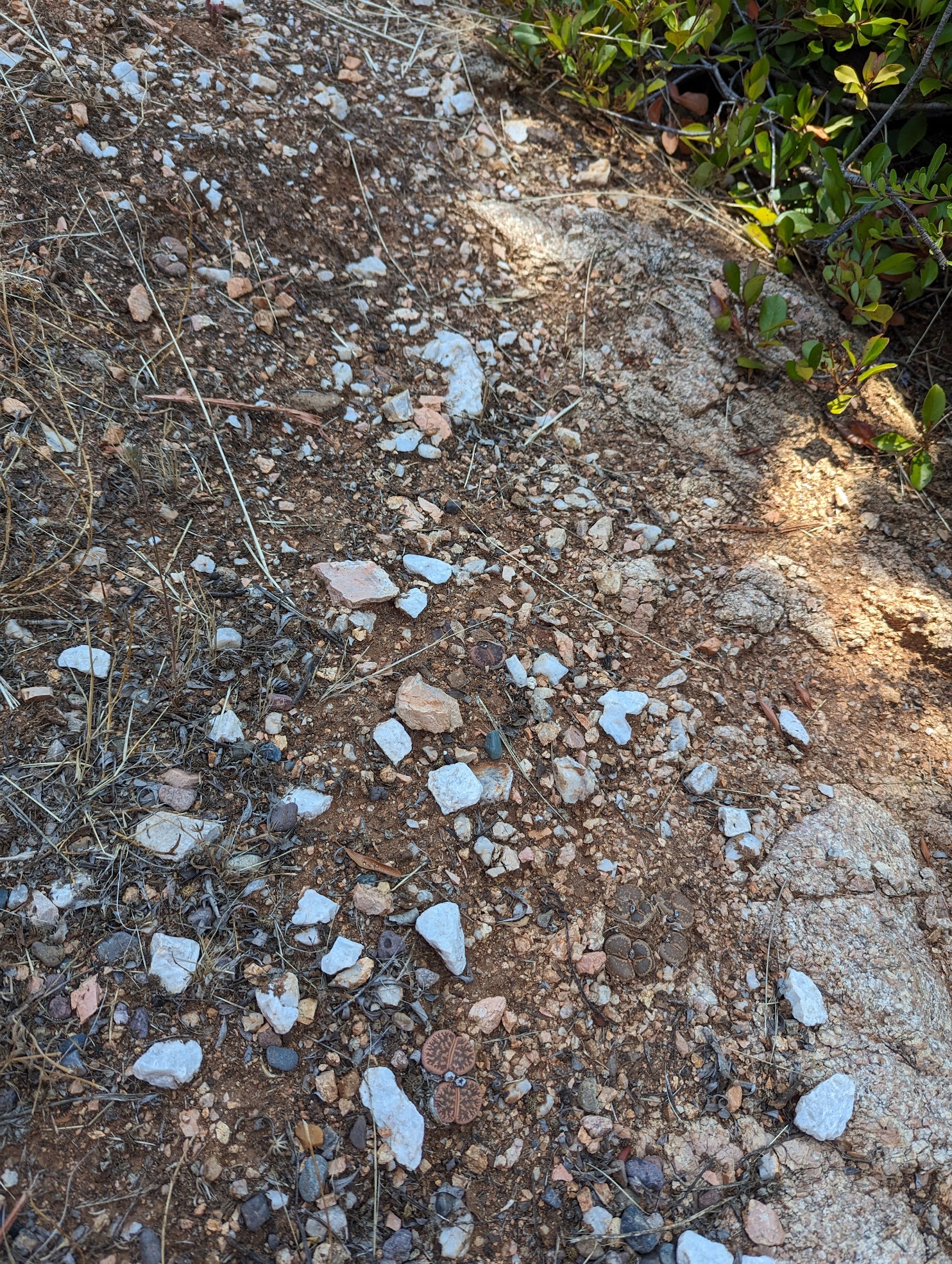
Above is the slope of all plants, after their first watering of the year in early June of 2024.
There’s 6! Can you see them all?
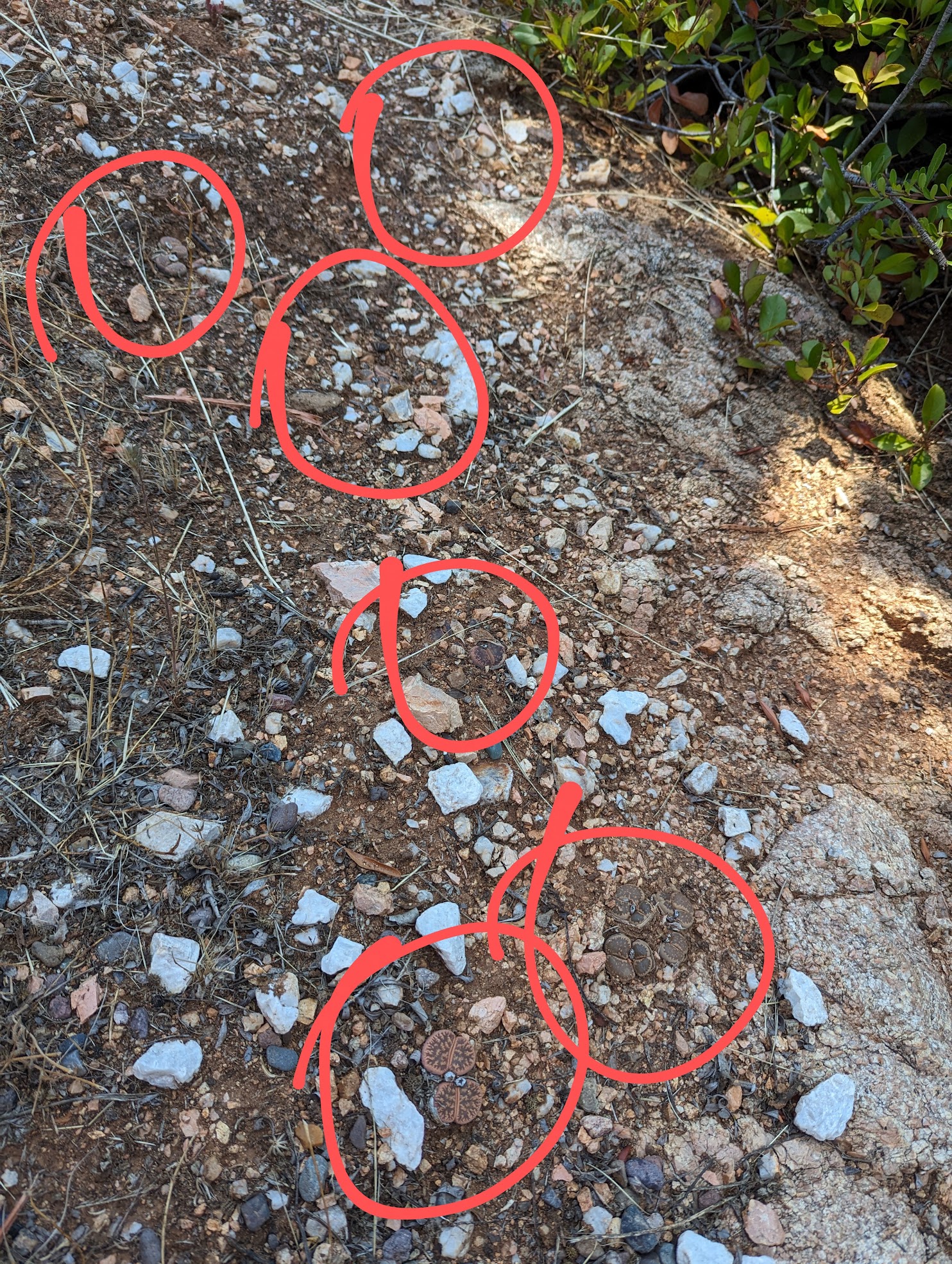
That might have been a little unfair – I didn’t share photos of the top 3. They are often hard to see, often covered in dirt, and often fall victim to nibbling from animals.
Two of the three! The greener-hued one you might be able to guess at; it’s next to the largest chunk of white rock (a large chunk of quartz).
The darker one is at the very top of the image, and is often hidden by the bush when it grows in during the summer. Despite the shade and shelter, it still has only two heads, compared to the increasing leaf pairs coming in for some of the other plants.
Can you do this too?
Unfortunately for many people, growing lithops in-ground only works in very specific situations.
I gave this a shot because my climate pretty closely lines up with the climate in South Africa where many of these are from…kinda. Namibia (the northern range for Lithops) sees most of its rainfall in summer, with some areas only seeing a couple inches of rainfall for the year while others get up to ten!
South Africa, meanwhile, can get up to 18″ in some areas…but where Lithops are found, it’s more often 6 to 8″ annually, with the inland regions that Lithops grow receiving their meager amounts of rain in summer.
Winter rainfall should, by all accounts, melt my little mesembs, but I’ve found this to not be the case. Providing summer rainfall in the form of my deep sprinkler waterings for the hottest times of the year also seems to mimic the type of water they’re used to getting.
This is all entirely at odds with what is recommended to grow these in pots. Don’t take any of this guidance about growing these in-ground as what you should do to grow them in pots! *I* don’t even do the same thing for my potted Lithops as I do for these in the ground.
If you want to give this a try, you’ll need to be living somewhere that gets hot in summer (90 – 100F at least), with very dry ambient conditions. Your winter lows should rarely hit freezing, and frost should be a rare event.
You’ll need a steep slope that drains well or struggles to hold onto moisture. You’ll know it’s a fit if you’re constantly struggling to give “normal” plants enough water to thrive. I strongly suggest finding a placement that has afternoon shade, especially if your summer highs are regularly over 95F.
The soil should be rocky, poor, and make you wonder if you should add something else to it (you shouldn’t).
You should also have fairly low humidity; my fellow southwestern desert people, you’re prime candidates to try this out. Floridians or Texans? Probably not. Or give it a shot and water yours way less than I do – maybe you can pull it off!
Are you going to try planting some Lithops in the ground?
Share your photos and how it goes with me! I’d love to hear from others who’ve done this successfully. It’s been one of my favorite experiments and it’s still going strong!

